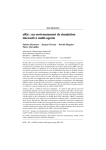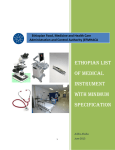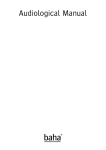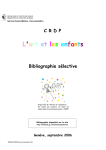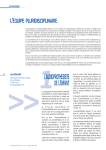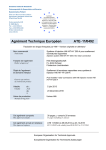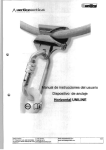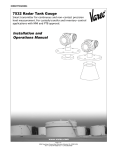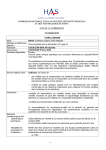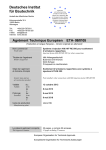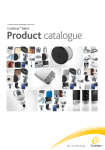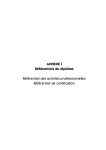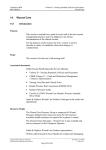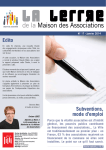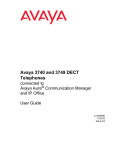Download E80560 BAHA OTM GB - Single
Transcript
Operating Theatre Manual sound sense for a better life Products in this manual are protected by the following patents: US 5 735 790, US 5 935 170, EP 0715839, EP 0715838 and corresponding patents in other countries and pending patent applications. All products can be subject to change without notice. No part of this publication may be replaced, stored in a retrieval system, or transmitted, in any form by means, electronic, mechanical, photocopying, recording or otherwise, without the prior written permission of the publisher. Caution: Federal law (USA) restricts this device to sale by or on the order of a medical practitioner. ©Entific Medical Systems AB, 2005. All rights reserved. Contents Contents • Introduction 4 • Audiological indications 5 • Patient selection 7 • Treatment planning 9 • Surgical components & instruments 11 • Preparation for surgery 14 • Packaging & titanium components 16 • Skin preparation 17 • Surgical technique Baha® FAST system 18 • Dressings 23 • Two-stage surgery Baha® FAST system 25 • Aftercare 28 • Paediatric surgery 29 • Complications & troubleshooting 30 • Clinic situations 33 • Previous drilling equipment & components 34 • Sterilization guidelines 35 • Implantmed sterilization guidelines 37 • References 39 Instrument and component preparation This publication sets forth detailed recommended procedures for using Baha® surgical components and instruments. It offers guidance needed for performing the procedure, but as with any technical guide, the surgeon must consider the particular needs of each patient and make appropriate adjustments when and as required. Note: The words fixture and implant are interchangeable and are used throughout this manual. Acknowledgement The protocol detailed in this manual originates from the clinical work carried out since 1977 by Dr. Anders Tjellström and colleagues at the Implant Unit, Department of Otolaryngology, Sahlgrenska University Hospital, Göteborg, Sweden. Baha® Operating Theatre Manual 3 Introduction Introduction Since 1977 osseointegrated implants have provided successful retention for bone anchored sound processors for ca. 25,000 patients. The system is called Baha and utilizes Brånemark System® implants in combination with a bone anchored sound processor. This system has proved to be a favourable means of providing hearing rehabilitation to certain groups of patients. The long-term predictability and success of such treatment is based on the fact that an active bond between bone and implant is created at the molecular level. The implant is not only accepted but in fact incorporated within the vital differentiated bone, which through remodelling gradually adapts to its new function. In order to create and maintain the appropriate structural and functional relationship between the biological and non-biological components, the various stages of treatment must be carried out with precision. The following are vital for achieving successful results: 1. The anchoring components should be made of a biocompatible material and with such geometrical shape and dimension that an appropriate mechanical system can be attached to them. 2. The implant surface should have an adequate micro architecture and not be contaminated during surgical placement, ensuring that an optimum interface surface is established during implant installation. 3. The implant site should be prepared with care and the implant installed in such a way that the capacity of the osseous tissues to form new bone is maintained. 4. The skin-penetration of the abutment is accomplished in such a way that relative skin movement is reduced. 5. The preparation of the skin-penetrating area should be carried out in such a way as to allow the skin to adhere to the underlying periosteum. In order to obtain optimal results, surgeons and audiologists should work in close collaboration. This collaboration should continue during the follow-up period. For a successful result it is necessary that the correct methodology, appropriate instrumentation and an interdisciplinary approach are maintained. Surgical workshops are available to learn more about Baha. Contact your local distributor for more information. 4 Baha® Operating Theatre Manual Audiological indications Audiological indications The indications for Baha treatment are described in the following section. Conductive and/or mixed hearing loss The Baha treatment is indicated for patients who have a conductive or mixed hearing loss and can still benefit from sound amplification. Patients who wear a conventional bone conduction (BC) hearing aid are generally most suitable for this procedure. SSD™ (Single Sided Deafness) The Baha treatment is also indicated for patients with a unilateral sensorineural deafness.1,2,3 The Baha device picks up sound on the deaf side and the sound is transmitted via bone conduction to the contralateral intact cochlea, offering a reduction of the head shadow effect and improved speech recognition in noise. Hearing thresholds For Baha ear level devices the pure tone average (PTA) bone conduction (BC) threshold of the indicated ear should be better than or equal to 45 dB HL (measured at 0.5, 1, 2, 3 kHz). Additionally a maximum speech discrimination score of 60% or better when using a phonetically balanced PB word list is recommended. However, the audiologist must determine whether the candidate has sufficiently good speech discrimination ability based on that particular patient’s need. For severe mixed hearing losses the Baha body worn device is an alternative. It works utilizing a K-amp with an adjustable threshold knee and loudness boost. Objective technical measurements show that the nominal output is on average 13 dB stronger than the ear level models (measured at 0.5, 1, 2, 3 kHz). For SSD™, Baha is indicated when the pure tone average air conduction (AC) threshold of the hearing ear is better than or equal to 20 dB HL AC and BC (measured at 0.5, 1, 2, 3 kHz). For bilateral fittings the recommendation is that BC thresholds should be symmetric, where the definition “symmetric” is less than a 10 dB difference on average (0.5, 1, 2 and 3 kHz) or less than 15 dB at individual frequencies. For detailed audiological and technical data for the sound processors, see the Audiological Manual. Otological indications • Patients with chronically draining ears, where the use of an AC hearing aid aggravates the infection, causes feedback problems, poor wearing comfort or poor sound quality (i.e. external otitis, draining otitis media, radical operated ears). • Patients presenting with congenital malformations and embryopathies where the cochlear function is good but where there are no ear canals are also good candidates for a Baha device. The possibility of creating an external ear canal to restore hearing with tympano-plastic procedures should be explored. • Patients with a conductive hearing loss due to ossicular disease who are not appropriate for surgical correction and are unable to be aided by conventional hearing aids. Baha® Operating Theatre Manual 5 Audiological indications • Patients with cochlear insufficiency in one ear and a conductive hearing loss in the other ear where there is a potential risk of making the only functioning cochlea unusable by ear surgery. • Patients with SSD due to acoustic tumour surgery, sudden deafness etc., who cannot or do not want to use an AC CROS. Additional indications • • • Biologically, titanium implants can be placed in most patients. Sufficient bone volume and bone quality must be present for successful implant placement. Alternative treatments should be considered for patients having a disease state that might jeopardize osseointegration. Patients must be able to maintain and clean the skin around the abutment (either by themselves or with the aid of others). Careful consideration must be given to the patient’s psychological, physical, emotional and developmental capabilities to maintain hygiene. In children responsibility falls on the parents or guardian. Children can be fitted, but treatment at an early age is dependant on the surgeon’s decision in relation to adequate bone depth. 1 F.M. Vaneecloo, I. Ruzza, J.N. Hanson, T. Gérard, J. Dehaussy, M. Cory, C. Arrouet & C. Vincent, 2002. 2 J.J. Wazen, J.B. Spitzer, S.N. Ghossaini, J.N. Fayad, J.K. Niparko, K. Cox, D.E. Brackmann & S.D. Soli, 2003. 3 A.J. Bosman, M.K.S. Hol, A.F.M. Snik, E.A.M. Mylanus & C.W.R.J. Cremers, 2003. 6 Baha® Operating Theatre Manual Patient selection Patient selection Pre-operative testing An additional test involves using the test rod or the testband (see Fig. 1 & 2 ). When using a test rod, the sound processor is connected to the rod and checked by blowing into the microphone. The vibrations can be felt through the rod when the sound processor is working. Fig. 1 The patient then holds the rod between their teeth or presses it hard against the mastoid. To avoid feedback, the lips must be closed and the sound processor itself must not be touched. An alternative to the test rod is the testband. It works in a similar way with the sound processor being attached to the band which is worn around the patient’s head. It is easier for the patient to try the sound processor in other listening environments as they are able to walk and move around with a testband. The sound quality of the test rod and the testband is damped compared to when the device is connected to an osseointegrated implant. The measured gain will be improved once the titanium implant is placed and the sound processor connected. The biggest improvement will be seen at higher frequencies where the attenuation through the teeth/skin is greatest. Fig. 2 Patient information and expectations It is important to give the patient realistic expectations of Baha. The patient should be well informed, have the right expectations and be motivated before getting a Baha sound processor. For example, a patient having problems with ear infections when using an AC aid should be informed that the main reason for him/her to use a bone anchored sound processor is to eliminate the ear infection and not to get a significantly better sound quality. On the other hand, those who previously used a conventional BC hearing aid will most certainly experience both improved sound quality and significantly improved wearing comfort since Baha works without any pressure against the skin. Appropriate counselling and explanation of these issues should be the routine so that patients have realistic expectations of Baha. Arranging for a patient candidate to meet an experienced Baha wearer is a good way to inform the patient about the treatment. For more detailed information about the fitting procedures, see the Audiological Manual. Selection of implant side From an audiological viewpoint, the side with the best cochlear function (the best bone conduction thresholds) should be used when fitting a bilateral hearing loss with one sound processor. Sometimes, however, it is difficult to judge which side is best from an audiogram. In such cases the testband/test rod can be of help. (Remember that the sound processor itself should not be touched.) The patient will be able to tell which side is better. It is the surgeon who chooses the implant site. It is important that the site is chosen bearing in mind that the sound processor, when fitted, should not touch the auricle as this can cause acoustic feedback. The plastic indicator in the surgical instrument set is designed for the purpose of correct positioning. Baha® Operating Theatre Manual 7 Patient selection Some practical considerations to take into account are: • Manual dexterity • Cosmetic aspects • Hair growth • Driving – if the patient regularly drives a car with a passenger (for example a taxi driver) then the side facing towards the passenger is a good option. • Telephone use – if the patient uses the telephone frequently, the opposite side to the “writing” hand may be the best choice. • Clothing – if the patient regularly wears a hat or helmet for work or during certain types of activities such as sport, special consideration should be given to the location of implant site. Bilateral implants For most patients with a symmetric moderate to severe bilateral conductive and/ or mixed hearing loss, bilateral fitting of Baha ear level devices improves sound localisation and speech recognition in noise, as the bilateral fitting of bone anchored sound processors does lead to binaural hearing 4, 5, 6. Symmetric bone conduction thresholds are defined as less than a 10 dB difference on average (0.5, 1, 2 and 3 kHz) or less than 15 dB at individual frequencies. Baha® for Single Sided Deafness (SSD™) Baha is indicated for those patients who suffer from unilateral sensorineural deafness in one ear and normal hearing in the other ear (normal hearing is defined as PTA AC threshold equal to or better than 20 dB measured at 0.5, 1, 2 and 3 kHz). These patients may have been offered an AC CROS but either cannot or will not use this type of device. The Baha sound processor is fitted on the deaf side and sound is transmitted through the bones of the skull to the functioning cochlea of the hearing ear (also referred to as transcranial routing of signal). Baha® Softband The softband is available for use in adults and children who are awaiting surgery or fitting and enables these patients to be aided during this time. It is mainly used by children until they reach a suitable age for surgery. The band can be worn from a very early age and for as long as required. The age for surgery is dependant on the clinician’s assessment of bone depth. Caution: This Product Contains Natural Rubber Latex Which May Cause Allergic Reactions. 4 8 Baha® Operating Theatre Manual S.N. Dutt, A.L. McDermott, S.P. Burrell, H.R. Cooper, A.P. Reid, D.W. Proops, 2002. 5 A.J. Bosman, A.D. Snik, C.T.M. van der Pouw, E.A.M. Mylanus, C.W.R.J. Cremers, 2001. 6 C. Priwin, S. Stenfelt, G. Granström, A. Tjellström and B. Håkansson, 2004. Treatment planning Treatment planning One-stage surgery with the Baha® FAST system One-stage Baha® FAST system surgery involves the placement of the implant and the pre-mounted abutment at the same time as the soft tissue work is carried out so that the patient has only one surgery and is able to have their sound processor fitted three months later. The one-stage technique should be considered as the clinical routine with a well documented protocol. As such, it forms the basis of all workshop programmes and is recommended for anyone taking up the technique. The one-stage procedure is suggested as the routine protocol in non-irradiated adult patients when the skull bone is greater than 3 mm thick. The surgery should be uneventful i.e. no contact with the dura mater of the middle cranial fossa or the wall of the sigmoid sinus. Two-stage surgery with the Baha® FAST system In children or compromised tissue, such as after irradiation or when there is generally poor bone quality, and in cases where the implant is to be placed at the time of Acoustic Neuroma removal, then a two-stage procedure should be used. For these cases an implant with a pre-mounted fixture mount is used and a cover screw is placed in the implant head. The implant is left to osseointegrate with the bone before abutment connection. At the second stage surgery an abutment is placed and the tissue reduction carried out. In these cases a longer osseointegration time of between 3–6 months is recommended before the abutment connection. The longer time of six months should be observed in paediatric patients and other cases where the bone quality requires additional attention. Note: Regardless of whether a one-stage or two-stage procedure is performed, the implant must not be loaded during the period of osseointegration. One-stage procedure should be chosen if all following criteria are fulfilled: • Adult • Good bone quality • Uneventful surgery Two-stage procedure should be chosen in any of the following cases: • Children • Irradiated patients • Poor bone quality • At the time of Acoustic Neuroma removal Baha® Operating Theatre Manual 9 Treatment planning One-stage Baha® FAST system Two-stage Baha® FAST system Surgical procedure Surgical procedure Fixture with pre-mounted abutment installation Fixture with pre-mounted fixture mount installation 6 6 Surgical follow-up Change dressing Time after surgery 1 week Remove dressing, stitches and healing cap 2 weeks Instruct patient on cleaning and aftercare 2 weeks Osseointegration period for 3–4 months Surgical follow-up Remove stitches Time after surgery 1 week 6 Osseointegration period for 6 6 3–6 months Surgical procedure 6 6 Abutment connection Fitting of the sound processor Surgical follow-up Change dressing Check and clean abutment Fit the sound processor Ensure patient’s ability to manage controls Ensure patient’s ability to remove and replace sound processor Time after 2nd surgery 1 week Remove dressing, stitches and healing cap 2 weeks Instruct patient on cleaning and aftercare 2 weeks 6 6 Fitting of the sound processor Clean and check abutment 3–6 weeks Fit the sound processor 3–6 weeks Ensure patient’s ability to manage controls 3–6 weeks Ensure patient’s ability to remove and replace sound processor 3–6 weeks 6 Note: For both the one-stage and two-stage procedures the abutment should be cleaned and checked when the sound processor is fitted and the patient’s ability to manage this should be confirmed. 6 Follow-up Time after fitting Asses need for accessories 6 weeks Asses patient management 6 weeks Check abutment, clean if necessary 6 weeks Full post-operative audiometric tests 6 months Subjective questionnaire comparing new device with patient’s previous device 6 months Routine checks including: • Stability of abutment Every 6 months • Overall performance of the Sound Processor Every 6 months • Skin condition around the abutment 10 Baha® Operating Theatre Manual Every 6 months Surgical components & instruments Surgical components & instruments Baha® surgical components Drills & disposables 1. Baha® Dermatome blade 1. 2. Guide drill, 3+4 mm 3. Drill countersink, 3 mm 4. Drill countersink, 4 mm 2. 3 & 4. 5. Biopsy punch ø4 mm Fixtures & healing cap 6. Self-tapping fixture with pre-mounted abutment, 3 mm length 7. Self-tapping fixture with pre-mounted abutment, 4 mm length 5. 6 & 7. 8. Self-tapping fixture with pre-mounted fixture mount, 3 mm length (mainly for twostage procedure) 8 & 9. 9. Self-tapping fixture with pre-mounted fixture mount, 4 mm length (mainly for twostage procedure) 10. Healing cap (for healing period) 10. Note: The pre-mounted fixture mount is disposable. For two-stage procedure 11. Cover screw, Unigrip (standard for two-stage procedure) 11 & 12. 12. Cover screw, internal hexagon (suitable for long term sleeper implants) 13. Abutment snap coupling 5.5 mm (for second stage) 13. Note: A selection of drills and self-tapping fixtures should be available for each operation. Unused components can be saved providing the sterile packaging remains intact. More details on these components can be found in the Product Catalogue and the Nurse/Surgical Assistant Quickguide. Baha® Operating Theatre Manual 11 Surgical components & instruments Surgical instruments Pick’n Place instrument set for Baha® The instrument set for Baha includes instruments for implant placement and abutment connection. A complete list of the instruments included is detailed below. 1. 2. 3. 4. 1. Surgical organizer, titanium 2. Dissector 3. Forceps, titanium 4. Raspatorium 5. Cylinder wrench 6. Screwdriver Unigrip 95 mm 7. Counter torque wrench 5. 6. 7. 8. 9. 10. 11. 12. 13. 14. 15. 12 Baha® Operating Theatre Manual 8. Drill indicator 9. Connection to handpiece 10. Fixture mount Unigrip 11. Indicator for Baha 12. Machine screwdriver Unigrip 25 mm 13. Hexagon screwdriver 20 mm 14. Abutment inserter 15. Instrument cassette Note: The instrument set does not include the Baha® Dermatome and this should be ordered separately. The dermatome blade and biopsy punch are disposable and should be ordered for each case. Surgical components & instruments Baha® Dermatome The Baha® Dermatome is an instrument designed to simplify the procedure of making a skin graft around the implant site. It cuts the skin flap to the correct thickness with an oscillating blade. The blade runs from the drill machine. The instrument is made up of the dermatome, a driver pin and a disposable blade. Drilling equipment W&H drilling equipment – Implantmed The W&H Implantmed drilling equipment consists of one control unit, one motor and one foot control (see Fig. 3). The Implantmed unit features several programmes covering the various stages in the surgical procedure. The drilling sequence during bone preparation, fixture/abutment insertion and the secure tightening of abutment screws at second stage can be set automatically. The programmes can be adjusted to the optimum speed and torque for each stage of the procedure. Note that the handpiece 20:1 WS-75 E/KM (with gear ratio 20:1) should always be used for Baha surgery to give the correct speed and torque. Programmes 3 and 4 can both be used for the drilling procedure. The speed can be easily adjusted by choosing the required programme and then pressing the plus (+) or minus (–) buttons. The selected maximum speed (rpm) is then shown on the display. The available speed range is 15–2000 rpm for the handpiece 20:1 WS-75 E/KM. Programme 5 is used for implant installation and screw tightening. This programme uses a fixed speed and the display shows the torque limitation value. The speed is fixed at 15 rpm in forward mode and 30 rpm in reverse mode. The torque control can be adjusted from 5 to 50 Ncm. The maximum torque is adjusted by pressing the plus (+) or minus (–) buttons and the selected torque is shown on the display. The Implantmed unit has a built-in roller pump that can be used for cooling instead of a manual syringe with saline solution. The pump can be switched on from the console or by using the foot control. Fig. 3 Note: The setting on the drilling unit is specially adjusted for the handpiece 20:1 WS-75 E/KM, i.e. changing the handpiece will result in an incorrect speed or torque, which may severely jeopardise the clinical result. Baha® Operating Theatre Manual 13 Preparation for surgery Preparation for surgery Sterile equipment and instruments Operating theatre The operating theatre is prepared for surgery in the same fashion as for ordinary ear surgery. The nurse scrubs, puts on a sterile gown and sterile gloves. All talcum is removed with damp gauze. Instruments and materials are unwrapped. Suggested preparation for one-stage surgical procedure Supplies necessary in operating theatre: • Implantmed drilling equipment • Selection of components; dermatome blade, drills, fixture/abutments, biopsy punch, cover screws and healing caps (healing caps must be sterilized before use) • Antiseptic solution for patient preparation (alcohol base) • Xylocain – adrenalin solution for local anaesthesia (10–15 ml) • 0.5 % Xylocain – adrenalin is used for haemostasis if the operation is performed under general anaesthesia • Suture material 5/0 Monosofil, non-absorbable • Marker pen/needle and dye • Dressing depending on choice, gauze and bandage • Sterile drapes in various sizes for patient Instruments and equipment Baha instruments: • Baha® Instrument set Pick’n Place • Baha® Dermatome Irrigation: • The Implantmed has a built in irrigation system. A bag of saline is attached to the unit and the disposable irrigation tubing attached. Handpieces: • The handpiece and motor are sterile and packed in a cassette. These should be mounted and, in order to dispose of excess oil, the motors are run for a couple of minutes in a vertical position with the tip down. The handpiece is then dried with a damp gauze dressing. Skin preparation: • Vaseline, liquid paraffin or mineral oil for dermatome Suction: • 1 suction tube • 2 plastic suction tips Prepping: • Sponge holders • Gauze • Stainless steel bowl 14 Baha® Operating Theatre Manual Preparation for surgery Surgical instruments (basic requirements): • 1–2 scalpels • 2 scalpel blades No. 15 • 2 self-retaining retractors • Periostal elevators • Skin hooks • Retractors • Tissue forceps • Dissecting scissors • Suture scissors • Needle holder • Mosquito clamps • Towel clamps • Syringe (L.A.) • Gauze Patient preparation In the operating theatre, the patient should be prepared as for any surgical procedure, i.e. the incision area should be shaved and sterile. Pre-medication and anaesthetics As pre-medication, Valium 10–20 mg/ml i.v. is recommended in adults. In adults the procedure is generally performed under local anaesthesia. In children general anaesthesia is preferred. 10 mg/ml Xylocain with 5 µg/ml adrenalin s.c. solution is recommended as local anaesthesia. 10–15 ml is generally enough, but this may vary depending on the number of implants to be installed. The anaesthetic should infiltrate the periosteum at the implant site. When the surgery is performed under general anaesthesia, the use of 5–10 ml 5 mg/ml Xylocain with 5 µg/ml adrenalin s.c. for haemostasis is recommended. Baha® Operating Theatre Manual 15 Packaging and titanium components Packaging and titanium components Sterile packaging system All titanium components and disposable drills are supplied in sterile packaging to make the work at the clinic simpler and more cost-effective. The sterile packaging provides a better guarantee that the titanium components and disposable instruments are clean, sterile and free from contamination. The sensitive titanium surface structures are safeguarded and the instruments maintain their precision and sharpness. Each peel-open package has the article, article number, date and code of manufacture and expiry date printed on it; the batch numbers are for documentation or patient records. The peel-open pack is sterile only if the package is intact. The sterile packaging system consists of two types of packages, either a peel open pack or a plastic ampoule within a peel open pack (see Fig. 4). A titanium pack sleeve is inside to hold the component. The plastic ampoule is placed in a blister package which is the sterile barrier. Note that the plastic ampoule is not a sterile barrier. It is only a holder for the component. The sterile component storage box is also sealed. How to handle titanium components The implant should not be in contact with anything but the pack sleeve prior to insertion in bone. Under normal circumstances, the plastic ampoule is placed in the Pick’n Place surgical organizer marked “Fixture” and then the implant is picked up from the plastic ampoule with either the abutment inserter or the connection to handpiece. If the implant needs to be handled in any other way, this should be carried out in the bowl for titanium components on the tray and with titanium forceps. Fig. 4 Other components such as drills, abutments and cover screws can be handled as any other sterile surgical component i.e. by the gloved hand or with suitable instruments. It is important to make sure that sharp instruments do not scratch surfaces and threads as this may reduce the performance of the component. There is no need to keep titanium and stainless steel instruments apart as it is commonly known that there is no risk of contamination that could jeopardise the clinical result. If a blister package containing a titanium implant is damaged, the implant must not be used. In order to achieve successful osseointegration it is essential that the surface of the titanium implant is kept clean and free from contamination. 16 Baha® Operating Theatre Manual Skin preparation Skin preparation Implant position Before the sterile field is made the planned implant site is carefully marked by a thin needle and dye. The implant site is identified with the aid of the indicator for Baha. The site should be located approximately 50–55 mm from the ear canal so that the sound processor will not touch the pinna in its final position (see Fig. 5). Placement of the implant low in the mastoid tip is not recommended and should be avoided! The location of specific anatomical landmarks i.e. temporal line, suprameatal spine, mastoid foramen etc is often helpful. Anatomical variations due to congenital malformation and/or prior surgery should be considered. Fig. 5 In congenital microsomia the size of the mastoid process may be small, the dura of the middle cranial fossa low, and the sigmoid sinus close to the surface. It is however almost always possible to find sufficient bone for an implant. In a patient who has a radical cavity there is seldom any problem in finding sufficient bone and a good position for an implant. Incision marking The marking is rectangular with dimensions of about 24×30 mm, where the smaller number is the width of the dermatome (see Fig. 6). In all cases the area should be marked so that the proposed implant site is positioned in the lower half of the flap to allow for sagging of the skin7. When to use the Baha® Dermatome Fig. 6 The dermatome may be used if the skin surface is even and normal. The dermatome may also be used in the second stage of a two-stage procedure as long as the skin surface is even. Additional care should be taken if the cover screw causes a ridge on the skin surface. In patients with varying bone quality where it might be difficult to find a good place for the implant, a manual incision and skin preparation should be considered instead. Clinical consideration for each patient should always be maintained. Instrument mounting of the Baha® Dermatome 1. The driver pin is mounted into the handpiece. 2. The blade is inserted into the dermatome with the single groove facing upwards. 3. The blade should be centred when inserting the handpiece into the dermatome. The driver pin should mate with the groove in the blade. 4. The securing screw should be lifted over the handpiece and tightened firmly. The function should be checked by running it with the high speed motor, 2000 rpm. 7 1 2 3 4 D.W. Proops, 1996. Baha® Operating Theatre Manual 17 Surgical technique Baha® FAST system Surgical technique Baha® FAST system The description of the surgical procedure below is based on a one-stage surgical procedure with the dermatome and self-tapping fixture with pre-mounted abutment. It may be helpful to use magnifying glasses with a working distance of about 30 cm. Generous cooling with saline solution or sterile water is used during some stages of the surgery. A conventional suction device is used. Electro coagulation is used with care in order to reduce tissue trauma. This is especially important in the irradiated patient. Incision The incision can be made using two different techniques, with the Baha® Dermatome or manually depending on the clinical situation (see above). Tissue reduction around the flap area is preferably best carried out when the exact implant position is known. Fig. 7 Incision using the Baha® Dermatome 1. The dermatome can be used either in the caudal, cranial or the ventral direction. The diagram above shows the use of the dermatome in the caudal direction (see Fig. 7). 2. The dermatome should always be used at speed 2000–3000 rpm. To facilitate cutting, a small amount of Vaseline, liquid paraffin or mineral oil may be used on the skin. 3. Cutting begins at the marked area. It is imperative to have the right angle to get a skin flap of uniform thickness (see Fig. 8). If the correct angle is not maintained the flap maybe cut off or the edges of the flap may be too thin to suture the flap back in place. 4. Firm pressure should be applied during cutting (see Fig. 9). 5. When the dermatome reaches the end of the marked area, it is stopped and pulled back carefully (see Fig. 10). Fig. 8 Note: The dermatome should have travelled over the whole of the marked area before pulling back. It is not possible to go back and continue cutting the flap after pulling out. Fig. 9 Fig. 10 18 Baha® Operating Theatre Manual Surgical technique Baha ® FAST system When the skin flap is complete, the subcutaneous tissue should be excised down to the periosteum using the edges of the flap as a guide. It is very important for the thin skin flap to be kept moist (see Fig. 11). A cruciate incision in the periosteum at the implant site is made and the edges are raised with the raspatorium (see Fig. 12). The soft tissue reduction with the undermining of the subcutaneous and surrounding tissue (see Tissue preparation, page 20) is either carried out before or after implant insertion. If a one-stage surgery was planned and the dermatome has been used, but due to clinical considerations the surgeon decides to postpone the abutment connection to a second stage surgery, the soft tissue preparation can be fully completed at the first stage surgery. The abutment can be disconnected from the self-tapping fixture with pre-mounted abutment by using the counter torque wrench and the screwdriver Unigrip. This solution is not recommended as the clinical routine. If the procedure has to be completed in this way it is important to make sure that sufficient pressure is applied to the skin flap during soft tissue healing. Since a healing cap cannot be used in this case, a 40 mm gauze pad may be placed over the flap with pressure applied by placing a number of sutures across the gauze and attached to the surrounding skin. Manual incision technique When using a manual technique a scalpel is used to make the incision (see Fig. 13). The mark that indicates where the implant is to be located is checked and the incision is made down to the periosteum which is incised separately, as when using the dermatome. The periosteum is then raised from the bone. Thinning of the flap is then preferably carried out after implant installation (see Tissue preparation). Fig. 11 Fig. 12 Preparation of the implant site – drilling The preparation of the implant site using the guide drill and a drill countersink is carried out with the drilling machine on the high speed setting. When rotating instruments are used, abundant irrigation with room temperature saline solution is preferable but sterile water may be used. The irrigation is directed at the tip of the drill at the point where it penetrates the bone surface. Fig. 13 The quality and quantity of the cortical bone and the spongiosa air cells are noted during initial penetration. The drilling begins with the guide drill with the spacer kept on 3 mm (see Fig. 14), and the drill indicator attached. During drilling with the guide drill the burr is moved up and down and around in the hole to ensure that the cooling solution reaches the tip of the drill. While gradually deepening and widening the hole with the guide drill, it is important not to over widen the section that will contain the implant threads as this may cause initial instability. The bottom of the hole is repeatedly checked visually and with the blunt dissector to check for bone at the base of the site. It should be noted that it is possible to penetrate the wall of the sigmoid sinus and expose the dura mater and therefore the surgeon should proceed with care. Fig. 14 Baha® Operating Theatre Manual 19 Surgical technique Baha® FAST system If there is adequate bone thickness, the spacer is removed, allowing drilling to continue to a depth of 4 mm. Drilling continues in the same manner using the whole length of the drill to allow space for the countersink (see Fig. 15). If, however, soft tissue is encountered, drilling should be terminated. In most adults there is sufficient bone volume for a 4 mm implant. Note: Cooling is very important for all drilling procedures. Heat can damage the bone tissue and jeopardise osseointegration. It is important that the drilling is carried out perpendicular to the skin surface, since this orientation will affect the orientation of the implant and the abutment. The drill indicator will facilitate correct drill orientation, and should be used with the drill countersink. It may also be used with the guide drill. After preparation of the primary hole for the implant, the next step is to widen the hole to the exact diameter. This procedure is performed with either a 3 or 4 mm drill countersink depending on the depth reached with the guide drill (see Fig. 16). Fig. 15 To ensure correct drill orientation it is recommended that the drill indicator is used. The countersink should be moved up and down during drilling whilst ensuring that the cooling solution reaches the tip of the drill. Bone chips should be removed frequently from the drill flutes. When the surface is uneven, the countersink allows the flange of the titanium implant to have maximum contact with the bone surface. The tip of the countersink is blunt in order to minimize the risk of damaging any tissue at the bottom of the hole. Tissue preparation There are two prerequisites for establishing and maintaining a reaction-free skinpenetration. Firstly, the skin surrounding the implant should be hairless to help keep the implant site clean. Secondly, the skin flap must be very thin to avoid movement of the skin around and in relation to the abutment. Fig. 16 It is vital the skin is prepared properly to avoid tissue and hair re-growth which will cause irritation or wound healing problems around the abutment thus leaving the patient unable to wear their sound processor. When using the dermatome, the correct thickness of the skin flap is reached more or less immediately. When performing the manual technique7, the skin flap should be thinned to less than 1 mm thickness and all hair follicles must be removed. There are several different techniques for making the skin reduction7. All subcutaneous tissue must be removed under the skin flap, in order to minimize skin mobility in relation to the abutment. If any subcutaneous tissue is left, the skin is likely to grow up along the abutment and cause skin irritation. It is also important to perform tissue reduction in the area around the flap, regardless of whether the surgeon is using the dermatome or a manual technique (see Fig. 17). Fig. 17 20 Baha® Operating Theatre Manual Surgical technique Baha ® FAST system The aim of the soft tissue reduction is to achieve a gradual tension-free sloping edge down towards the flap area. The skin edges and the skin flap are sutured down to the periosteum. Keeping the periosteum intact is extremely important for the blood supply required for the healing of the skin flap. After completing the soft tissue preparation the skin flap is laid back and stretched out with skin hooks (see Fig. 18). A hole is punched exactly over the site of the implant hole, with a ø4 mm biopsy punch (see Fig. 19). Implant installation For implant insertion the low speed setting on the motor, which is marked with a picture of a fixture, should be used. The torque limit setting on the drill panel should be adjusted to suit the quality of the bone. In compact cortical bone a setting between 30 to 40 Ncm is recommended. In soft bone a lower torque setting of 10 to 20 Ncm should be used. Fig. 18 The self-tapping fixture with pre-mounted abutment is seated in a titanium cylinder and is delivered sterile. The ampoule is opened by unscrewing the lid so that the bottom section can be placed in the holder on the tray (see Fig. 20). The self-tapping fixture with pre-mounted abutment is picked up with the abutment inserter. It is recommended that the drill indicator is also used during implant insertion (see Fig. 21). The implant is installed without cooling until the small grooves in the distal end of the implant are well within the canal. (Irrigation at this time results in cooling solution being compressed into marrow spaces in the bone by the implant.) After this, the implant placement continues under abundant irrigation. If the implant enters the hole incorrectly, the drill motor is put in reverse and the implant is unscrewed. The correct angle is then found and the implant re-inserted. Here the drill indicator may be useful to set the correct angle. Fig. 19 Fig. 20 When the flange of the implant has reached the bone surface it stops automatically. The abutment inserter is then removed from the abutment (see Fig. 22). Caution should be observed in order to avoid loosening the implant through a lever arm effect. This is especially important if the implant site consists of a thin layer of bone combined with loose marrow and cancellous bone tissue. Fig. 21 Fig. 22 Baha® Operating Theatre Manual 21 Surgical technique Baha® FAST system The skin flap is now positioned with the hole being pulled on over the abutment. If necessary, two small incisions can be made to help ease the skin over the abutment (see Fig. 23). The flap is then sutured in position (see Fig. 24). The Healing cap Finally the healing cap is attached to the abutment to hold the dressing in place and prevent the formation of haematoma (see section on Dressings for dressing of choice). The implant is left to osseointegrate with the bone for three months (up to six months for certain patients as described above) before fitting the sound processor. Fig. 23 7 Fig. 24 22 Baha® Operating Theatre Manual D.W. Proops, 1996. Dressings Dressings Care is taken in the choice of dressing and aftercare of the wound. Traditionally the graft has been dressed with ointment soaked ribbon gauze wrapped around the abutment to avoid the formation of a haematoma. Great care is required to apply ribbon gauze evenly in order to avoid obstructing the blood supply as this would cause tissue necrosis and may disturb the graft. Tissue damage can occur as gauze dries and adheres to the wound. It is also difficult to remove and uncomfortable for the patient. New wound care techniques can reduce complications, increase comfort for the patient and decrease the time required by the clinician. There are now many dressings available, but for a graft site it is generally accepted that a non or low adherent wound contact layer and light pressure dressing will be adequate. Many types of dressings are suitable, but a few suggestions follow. Foam dressing A foam such as Alleyvn* Hydrocellular (Smith and Nephew), which is a hydrophyllic, polyurethane dressing with a trilaminate structure. It has threedimensional polyurethane net, which is low adherent to the wound interface. It is made from hydrophilic foam which absorbs and retains fluid and has an outside layer of opposite film. It can be used for low to medium exuding wounds and can be cut to shape to fit around the abutment and healing cap. The dressing can be left in place for up to seven days. Soft silicone wound contact layer A soft silicone mesh such as Mepitel® * * (Mölnlycke) which is a non-adherent dressing made of a medical grade silicone gel bound to a soft and pliable polymide netting which allows the passage of exudate. This is an ideal wound contact layer as it does not adhere to the wound at all, can be left in place for seven days and can be cut to size. In some hospitals this dressing is quite widely used and is available in most ward areas or Accident & Emergency. Antiseptic dressing An antiseptic such as Inadine® * * * ( Johnson & Johnson) is a low-adherent knitted viscose dressing impregnated with 10 % povidone-iodine in a water soluble polyethylene glycol base. It is generally used for the prophylaxis and treatment of a wide range of bacterial, protozoal and fungal organisms. Inadine needs to be used in conjunction with gauze as it does not have any absorption properties. Can be cut to shape and left in place for 5–7 days or until colour is lost. *Allevyn is a trademark of Smith & Nephew **Mepitel® is a registred trademark of Mölnlycke ***Inadine® is a registred trademark of Johnson & Johnson Baha® Operating Theatre Manual 23 Dressings Dressing protocol using foam Operating theatre dressing: • Cut or biopsy punch a ø4 mm hole in foam dressing • Apply over abutment directly on to the wound • Healing cap to hold in place • Cover with gauze and mastoid pressure bandage One day post op: • Remove outer bandage • Leave foam dressing and healing cap in place • Keep dry 5–6 days post op: • Remove healing cap • Carefully remove foam dressing • Gently clean wound with normal saline and gauze • Remove any dried blood • Re-apply foam dressing and healing cap • Patient can wash hair if dressing is protected 10–14 days post op: • Remove foam dressing • Remove sutures • Gently clean any dried blood or scabs • Patient can wash hair • If healed, no further dressing required Dressing protocol using silicone or antiseptic wound contact layer Operating theatre dressing: • Cut or biopsy punch a ø4 mm hole in the dressing • Place over abutment directly on to the wound • Apply at least two layers of gauze to exert pressure to graft • Healing cap • Cover with gauze and mastoid bandage One day post op: • Remove outer bandage • Leave the dressing, gauze dressing and healing cap in place • Keep dry 5–6 days post op: • Remove healing cap • Carefully remove dressing and gauze dressing • Gently clean wound with normal saline, gauze or tips • Remove any dried blood • Re-apply dressing and gauze dressing and healing cap • Patient can wash hair if dressing is protected 10–14 days post op: • Remove the dressing • Remove sutures • Gently clean any dried blood or scabs • Patient can wash hair • If healed, no further dressing required 24 Baha® Operating Theatre Manual Two-stage surgery Baha® FAST system Two-stage surgery Baha® FAST system Two-stage surgery is carried out on: • Children • Patients with irradiated bone • Patients undergoing Acoustic Neuroma removal concurrent with implant placement • Patients with poor bone quality Manual incision technique When two-stage surgery is the preferred choice then a manual incision technique is used. A mark to indicate where the implant is to be located is made with a needle and dye and the incision is made down to the periosteum (see Fig. 25 & 26). The flap is then raised leaving the periosteum intact, a cruciate incision is made at the site of the implant and the edges of the periosteum are raised using the raspatorium (see Fig. 27). Thinning of the subcutaneous tissue is carried out at the second stage surgery (see Tissue reduction). Fig. 25 Preparation of the implant site The preparation of the implant site using the guide drill and a drill countersink is carried out with the drilling machine on the high speed setting. When rotating instruments are used, abundant irrigation with room temperature saline solution is preferable but sterile water may be used. The irrigation is directed at the point where the drill penetrates the bone surface. The quality and quantity of the cortical bone and the spongiosa air cells are noted during initial penetration. Fig. 26 The drilling begins with the guide drill with the spacer kept on 3 mm (see Fig. 28), and the drill indicator attached. It is very important to use the drill indicator to create the correct angle as, if the implant is placed at an incorrect angle, it will affect the position of the sound processor. During drilling the guide drill is moved up and down and around in the hole to ensure that the cooling solution reaches the tip of the drill. While gradually deepening and widening the hole with the guide drill, the bottom of the hole is repeatedly checked with the blunt dissector. It should be noted that it is possible to penetrate the wall of the sigmoid sinus and expose the dura mater and therefore the surgeon should proceed with care. Fig. 27 If there is adequate bone thickness, the spacer is removed, allowing drilling to continue to a depth of 4 mm. Drilling continues in the same manner using the whole length of the drill to allow space for the countersink (see Fig. 29). If, however, soft tissue is encountered drilling should be terminated. In most adults there is sufficient bone volume for a 4 mm implant. gical Technique After preparation of the primary hole for the implant, the next step is to widen the hole to the exact diameter. This procedure is performed with either a 3 or 4 mm drill countersink depending on the depth reached with the guide drill (see Fig. 30). To ensure correct drill orientation it is recommended that the drill indicator is used throughout all drilling. The countersink should be moved up and down during drilling whilst ensuring that the cooling solution reaches the tip of the drill. Bone chips should be removed frequently from the drill flutes. When the surface is uneven, the countersink allows the flange of the titanium implant to have maximum contact with the bone surface. The tip of the countersink is blunt in order to minimize the risk of damaging any soft tissue at the bottom of the hole. Fig. 28 Fig. 29 Fig. 30 Baha® Operating Theatre Manual 25 Two-stage surgery Baha ® FAST system Implant installation For implant insertion, the low speed setting on the motor, which is marked with a picture of a fixture, should be used. The torque limit setting on the drill panel should be adjusted to suit the quality of the bone. In compact cortical bone a setting between 30 to 40 Ncm is recommended. In soft bone a lower torque setting of 10 to 20 Ncm should be used. Fig. 31 The self-tapping fixture with pre-mounted fixture mount is seated in a titanium cylinder and is delivered sterile. The ampoule is opened by unscrewing the lid so that the bottom section can be placed in the holder on the tray (see Fig. 31). The self-tapping fixture with pre-mounted fixture mount is picked up with the connection to handpiece and the drill equipment handpiece, matching up the square in the handpiece to the square on top of the fixture mount. It is recommended that the drill indicator is also used during implant insertion (see Fig. 32). The implant is installed without cooling until the small grooves in the distal end of the implant are well within the canal. (Irrigation at this time results in cooling solution being compressed into marrow spaces in the bone by the implant.) After this, the implant placement continues under abundant irrigation. If the implant enters the hole incorrectly, the drill motor is put in reverse and the implant is unscrewed. The correct angle is then found and the implant re-inserted. Here the drill indicator may be useful to set the correct angle. Fig. 32 When the flange of the implant has reached the bone surface, the handpiece is lifted off the fixture mount and the mount is removed using the screwdriver Unigrip and the cylinder wrench (see Fig. 33). Caution should be observed in order to avoid loosening the implant through a lever arm effect. It is very important to use the cylinder wrench. This is especially important if the implant site consists of a thin layer of bone combined with loose marrow and cancellous bone tissue. Fig. 33 Cover screw placement In a two-stage procedure a cover screw is inserted into the implant to protect the internal threads during the healing phase. The cover screw is picked out of the ampoule using the Unigrip screwdriver and screwed into the internal threads of the implant. If the cover screw Unigrip is considered to be too high in profile, the cover screw space with internal hexagon can be used instead as this provides the lowest profile. Note however that the space screw does not cover the head of the implant (see Fig. 34). Fig. 34 After inserting the cover screw the edges of the periosteum are placed over the flange of the implant and then the flap is sutured in position (see Fig. 35). A standard mastoid dressing is left in place for 1–2 days. After this the dressing is removed and a small bandage is all that is necessary. After a day or two most patients can regain normal activity. Before the second stage surgical procedure is performed the implant is left for a period of 3–6 months during which time osseointegration takes place. Fig. 35 26 Baha® Operating Theatre Manual Two-stage surgery Baha® FAST system Second stage surgery Tissue reduction Depending upon the clinical situation and position of the cover screw, the flap can be raised using either the dermatome or a manual incision (see section on Surgical technique, Incision). The subcutaneous tissue reduction can be carried out at this stage the aim being to achieve a gradual tension-free sloping edge down towards the flap area (see Fig. 36). Fig. 36 The flap is laid back and a hole is punched exactly over the cover screw head, with a ø4 mm biopsy punch and then the flap is laid over the skin again. The cover screw is removed using the Unigrip screwdriver (see Fig. 37). The abutment ampoule is placed in the holder on the titanium tray (see Fig. 38). The abutment is picked up with the counter torque wrench. The abutment should be correctly fitted on to the hexagon head of the implant (not resting on top of the hexagon) in order to avoid subsequent loosening of the abutment. The abutment is placed onto the implant, pressed down and then carefully rotated so that it seats over the hexagon. The abutment screw is initially tightened with the screwdriver Unigrip placed through the counter torque wrench (see Fig. 39). To ensure sufficient tightening of the abutment screw it is recommended that the machine screwdriver Unigrip on the low speed setting is then used (see Fig. 40). The abutment screw should preferably be tightened to a maximum of 25 Ncm. When tightening the abutment screw it is important to hold the counter torque wrench firmly to minimize the load on the implant. The screw is tightened whilst simultaneously counteracting the applied force with the counter torque wrench. Note that the abutment should be correctly fitted on to the hexagon head of the implant before tightening the screw. Fig. 37 Fig. 38 Once the abutment is in place the flap is laid back so that the abutment can be placed through the hole. The flap can then be sutured down and a healing cap and dressing can be placed as in the one-stage procedure (see section on Dressings). Fig. 39 Fig. 40 Baha® Operating Theatre Manual 27 Aftercare Aftercare The dressing and stitches should be removed 10–14 days after surgery if the area has healed. If the area has not healed properly a dressing should be worn for longer. It is very important that the patient maintains a good cleaning routine. Once the dressing has been removed and the abutment is exposed, the skin around the abutment must be cleaned every few days as debris may build up. The best way to do this is whilst the patient washes their hair as shampoo and warm water will help to soften any crust that may have built up around the base of the abutment. For the first few weeks a strip from a non alcohol baby wipe can be used to clean around the area until it is sufficiently healed to be gently brushed with the soft cleaning brush. The bristles should be aimed against the side of the abutment and not at the skin as care must be taken not to brush the skin too harshly (see Fig. 41). The debris build up is not a scab and must be removed. As build up may also occur inside the abutment itself, it is important to clean inside as well as around the abutment (see Fig. 42). A plastic snap is attached to the sound processor. It is designed to snap into the abutment and hold the sound processor securely in place. The inside of the abutment should be kept clean so that the connection with the snap and the abutment is optimal. Fig. 41 Any type of soap or shampoo can be used, but antibacterial soap is suggested. After cleaning, the area around the abutment should be dried with a non alcohol baby wipe. The hair must not be allowed to wrap itself around the abutment and, if using a hairdryer, hot air should not be directed at the abutment for too long. The soft brush should be kept clean and it should be renewed regularly, about every three months. With the sound processor removed patients are able to go swimming, play sports, sauna and hair can be permed or coloured. The abutment area can always be protected with a sweatband during sports if needed. Fig. 42 28 For more information see the Patient Aftercare brochure. Baha® Operating Theatre Manual Paediatric surgery Paediatric surgery Surgery on children should only be performed by surgeons already experienced with Baha surgery in adults. Since the skull is thinner and the bone quality softer in children, especially in small children with congenital malformations, a modified surgical technique might be required8. For children the two-stage procedure should always be used. We also recommend a second implant to be “banked” for possible future use. The reason for putting a “sleeper implant” in children is that the child does not have to be without Baha for any length of time if an implant does fail. They will only be without their sound processor for a few weeks while the soft tissue around the abutment on the sleeper implant heals. The second implant should be placed at a distance of approximately 15 mm from the first one. Ø����� Fig. 43 The lowest torque setting on the drill equipment should be used for both tapping and implant installation. Because of the lack of bone volume it is sometimes not possible to install even the short 3 mm implant completely. The flange will then be at a distance from the bone surface. To achieve more bone volume up against the flange around the implant, an expanded polytetrafluoroethylene membrane can be used9. The membrane, which should be about 20 mm in diameter, is placed on top of the implant and kept in place with the cover screw (see Fig. 43 and 44). The periosteum is sutured in place with resorbable suture material and the skin flap with monofilament nylon sutures (see Fig. 45). The implant should be left for at least six months before the abutment connection is performed in order to achieve sufficient new bone formation under the membrane. Note that the membrane must be removed during the abutment connection surgery. Fig. 44 The patient and the parents should be instructed that the traditional bone conductor (for example the Baha® Softband), should not be placed over the implants during the healing period. The second stage surgery (skin reduction and skin penetration) is performed as usual. Artefacts caused by the implants are minor. Fig. 45 8 9 Granström et al., 2001. Granström et al., 1999. Baha® Operating Theatre Manual 29 Complications and troubleshooting Complications and troubleshooting The incidence of complications is very low and the success rates for Baha are high. However, clinical studies show that there are times when a few complications may occur – see guide below. Safety, effectiveness and complications before surgery Listed below are some of the potential complications, relating to safety and effectiveness, that patients should be made aware of and consider before surgery: • Paresthesia • Perforation of the dura • Infection of the bone leading to osseonecrosis • Subdural haematoma • Meningitis • Inadequate temporal bone depth • Skin graft loss • Local or systemic infection • Implant mobility • Failure of the sound processor to dislodge if trauma occurs causing displacement of the implant. • It is important to instruct patients regarding situations that may be potentially harmful to the sound processor such as magnetic fields (MRI) and participation in sporting activities. Troubleshooting Position of site • If the site is placed too close to the pinna then the sound processor may catch against the back of the pinna and cause feedback problems. • If the site is placed too far away, high/low or a long way back from the pinna it is more difficult for the microphone to pick up sound and the sound will not seem as loud. This is particularly important with the directional microphone. From an aesthetic point of view it is better if the sound processor is not too far back as it is more discreet if it is hidden behind the pinna. Tissue and flap • If too much lubrication is used with the dermatome this may cause it to slide and it will not cut properly. • If the dermatome blade is put in incorrectly or upside down, it may not move correctly. This will prevent it from cutting and damage to the locking screw may occur. In this case it will also damage the blade so that a new one is required. • If the flap is damaged and cannot be put back in place, an alternative is to take a hairless skin graft from, for example, the retro auricular fold. The ideal situation is a split thickness skin graft placed directly on the bone or periosteum. • A patient who has very thick skin or constant re-growth of the subcutaneous tissue may need a longer abutment. An 8.5 mm abutment is available as a custom design product. • Inflammation and infection around the skin-penetrating abutment may be due to movement of the skin in relation to the implant. This can be caused by excessive thickness of the subcutaneous tissue layer, a loose 30 Baha® Operating Theatre Manual Complications and troubleshooting • • • • abutment or the fact that the implant is not integrated in the bone. These phenomena may result in pain. If hyper mobility of the skin is the reason for irritation around the implant, a subcutaneous tissue reduction should be performed. In such cases it is recommended that the patient is closely followed post-operatively and that a light pressure dressing is applied for 2–3 weeks. During the first weeks after surgery, partial, or even on rare occasions, sub-total graft and flap necrosis has been seen. However, conservative treatment has been successful in these situations, although the healing period may be extended. Poor personal hygiene or inappropriate vigorous cleaning may also cause irritation. Sharp instruments should be avoided at the interface. Alcohol or chlorhexidin solution should not be used. Long standing infection around the implant should be cultured and the relevant antibiotic be given orally. If the implant is not integrated it should be removed. The implant site in the bone is carefully curetted and the defect filled with blood coagulates. New bone formation will take place and one year later it should be possible to put a new implant in the same place. However, in most cases adjacent bone is available and suitable for the placement of another implant. At the same time the loose implant is removed. Drills and implants • The guide drill must be used to its full length so that sufficient depth is reached for the drill countersink. • The countersinking should be even so that the flange on the implant seats correctly keeping the implant perpendicular to the skin. This will facilitate the correct positioning of the sound processor. • Sometimes an air pocket may occur while drilling, taking the drill into another direction. In this case a new site should be chosen. • When placing the implant in hard bone pressure may need to be applied as the implant is inserted. This applies only at the initial insertion – once the implant has entered the bone no further pressure should be applied. If the implant stops it should be reversed out a few threads and then reinserted. • The torque can be adjusted depending on the quality and hardness of the bone. This should be done gradually, but can be raised to a torque of 50 Ncm. • If the abutment is tightened insufficiently at second stage or at abutment change, it may become loose and a skin infection may develop. Note: Any implant losses should be reported to your area Entific representative for monitoring. Mechanical complications • There must always be sterile-packed duplicates of all instruments and components. • The implant can be inserted manually if needed with the aid of the cylinder wrench. The abutment inserter is released from the handpiece and the cylinder wrench is placed on top of the self-tapping fixture with the pre-mounted abutment. The wrench is locked by pressing the handles together. The abutment inserter Baha® Operating Theatre Manual 31 Complications and troubleshooting should be seated properly over the abutment. The cylinder wrench is then rotated until the implant flange has reached the bone surface. • If the flange does not reach the bone surface then the counter torque wrench may be used to check the final tightening of the implant. This should however be carried out with great care in order not to damage the bone. This manual procedure is also performed under abundant irrigation. Note that the implant does not need to be tightened any further into the bone after the flange has reached the bone surface. MRI (Magnetic resonance imaging) The implant and the abutment can be left in place if the patient has to undergo MRI. The sound processor should however always be removed during MRI. Scientific studies have shown that the effects are negligible10. 10 32 Baha® Operating Theatre Manual C. Devge, A. Tjellström, H. Nellström, 1997. Clinic situations Clinic situations In certain situations the abutment may need to be removed and either repositioned or replaced with a new abutment e.g. if it has become loose, if the skin around the abutment requires extra care or if a new abutment is required for whatever reason. This normally happens in the follow-up clinic and not in the operating theatre. The area around the abutment should be washed and cleaned. The original abutment is loosened and unscrewed using the screwdriver Unigrip placed through the centre of the counter torque wrench. The counter torque wrench should always be used to reduce torque transferred to the implant in the bone. The snap coupling abutment may then be easily lifted away from the implant. The opening in the skin should then be cleaned and, if using a new abutment, the new snap coupling abutment ampoule is opened. The abutment is picked up with the counter torque wrench and placed onto the implant. It should be carefully rotated so that the abutment fits onto the hexagon head of the implant. The abutment screw is initially screwed down with the screwdriver Unigrip. When securing the abutment screw it is important to use the counter torque wrench to reduce the torque. The screw must then be tightened down to 25 Ncm using the Unigrip torque driver which is placed through the counter torque wrench and then tightened down by clicking the torque section round twice to reach 25 Ncm (see Fig. 46). Fig. 46 The whole procedure takes a few minutes and no local anaesthesia is needed. Note: The need to change the snap abutment is rare, but might be necessary in certain cases. For more details see Torque Driver Manual. Changing the bayonet and Baha® Cordelle I abutment for the snap coupling abutment This procedure takes a few minutes and local anaesthetic is not required. The area around the abutment should be washed and cleaned and, for the bayonet abutment, the plastic insert with O-ring is removed using the insert tool. This will expose the gold screw securing the abutment to the implant. There is likely to be some debris in the four small slots in the screw head. These slots should be cleaned with a sharp needle (and water if necessary) to remove the debris to ensure that the four tipped screwdriver fits properly. Before the abutment screw is unscrewed the abutment wrench (fork-shaped instrument) should be slid along the groove in the outer surface of the abutment to reduce torque on the implant. It is important to have some counter force when unscrewing the abutment as torsion forces on the implant should be avoided. The gold screw is then unscrewed using the four tipped screwdriver and removed, and the abutment is then lifted off. The opening in the skin should be cleaned. The snap coupling abutment ampoule is opened and the abutment picked up with the counter torque wrench. The abutment is placed onto the implant and carefully rotated so that it fits exactly onto the hexagon head of the implant. When tightening the abutment screw it is important to use the counter torque wrench to reduce the torque. The abutment screw is initially screwed down with the screwdriver Unigrip. The diameter of the snap coupling is slightly smaller than the bayonet abutment and there may be a small gap between the skin and the snap coupling. This is normal and does not affect the function of the coupling. The abutment can then be tightened down to 25 Ncm using the Unigrip torque driver, ensuring that the counter torque wrench is still in place. The patient may use antibiotic ointment around the coupling for a few days if needed. Baha® Operating Theatre Manual 33 Previous drilling equipment and components Previous drilling equipment and components Surgical instruments Prior to the self-tapping fixture with pre-mounted fixture mount, the flange fixture was mounted manually using a fixture mount, a mounting instrument and a slot screwdriver. This was performed by sliding the mounting instrument down onto the fixture mount and then placing them together on top of the fixture and locking the hexagon together. The fixture mount was tightened onto the implant using the slot screwdriver and then the mount and fixture could be picked up together with the connection to handpiece. Bayonet abutment The previous abutment was the bayonet abutment which was placed using an open ended wrench and four tipped screwdriver. The abutment wrench was slid along the groove in the outer surface of the abutment to reduce torque on the implant. The gold screw was then tightened with the four tipped screwdriver. The bayonet abutment was removed in the same way using the same instruments, but by turning the gold screw anti-clockwise. Note: Before changing from the bayonet to the snap abutment the insert and Oring must be removed (see section on Clinic situations). Previous drilling equipment – Controller set The previous drilling equipment, the controller set, consists of one high speed drill controller unit and one low speed torque controller unit. When using the drill and torque controller together, only the foot control included in the drill controller should be used. Contra-angle handpieces: The shank, with the blue ring, and the head with a green dot should always be used with the torque controller unit. For the drill controller unit, the shank with the black ring and the head with a green dot should be used. There is a drill indicator for use with the DEC 330 which is used with the drill controller unit. Note: The motors for the controller set are not autoclavable. Irrigation equipment for the Controller set The twin nozzle and disposable irrigation are used with the controller set to attach the irrigation. The twin nozzle is attached to the handpiece and the disposable irrigation is connected to it and to the bag of saline. Please see Controller Set Manual for further information. 34 Baha® Operating Theatre Manual Sterilization guidelines Sterilization guidelines The devices shall be reprocessed in accordance with established local routines for surgical instruments at the hospital clinic. Entific Medical Systems gives the following recommendations: Warnings Do no exceed 137˚C (278.6˚F) Limitations on reprocessing Repeated processing has minimal effect on these instruments. End of life is normally determined by wear and damage and due to use. Instructions Containment and transportation It is recommended that the instruments are reprocessed as soon as is reasonably practical following use. If the reprocessing is delayed the instruments should be submerged into disinfectant solution to prevent drying. It is not recommended to use aldehydes, such as glutaraldehyde and formaldehyde, as disinfectors for instruments that are not properly cleaned. Preparations for cleaning Before cleaning the following instruments should be disassembled. Small parts/screws can remain in the small box in the cassette during washing and be assembled afterwards. • • • • Fixture mount standard Unigrip Fixture mount short Unigrip Dermatome Cylinder wrench Cleaning: Automated All reusable surgical instruments, including instruments with plastic parts, can be automatically cleaned combined with thermal disinfection: Equipment: Automatic standard approved washer-disinfector. Detergent: Low alkaline detergent recommended from the manufacturer of the washerdisinfector. Final rinsing phase/disinfection stage: 85–93˚C (185–199.4˚F) for 1–3 minutes. Water quality: Processed water or according to the hospitals procedure. When unloading the washer-disinfector, check the narrow parts on the instruments for complete removal of visible soil. If necessary repeat cycle or use manual cleaning. Cleaning: Manual All other surgical instruments, including instruments with plastic parts, can be manually cleaned: Equipment: Interdental brush soaked with detergent solution. Items that can be submersed under water should be cleaned and brushed under water in order to avoid aerolisation spray. If additional cleaning is necessary, put the instrument in a manual ultrasonic bath. Detergent: All commonly used low alkaline detergents for surgical instruments. Initial pre rinsing phase: Rinse in cold water. The temperature should not exceed 35˚C (95˚F) in order to prevent the blood to coagulate. Final rinsing phase: Rinse carefully in hot water until the instruments are free from all detergent solution. Water quality: Processed water or according to the hospitals procedure. Chemical disinfection Before the manual cleaning if risk for infection, otherwise after the manual cleaning. It is not recommended to use aldehydes, such as glutaraldehyde and formaldehyde, as disinfectors for instruments that are not properly cleaned. Disinfectants: All commonly used disinfectants for surgical instrument or alcohol (ethanol: 70 v/v, or isopropanol: 45 v/v) with additive of surfactants. Let the instruments soak in the disinfectant solution for at least 10 minutes. Baha® Operating Theatre Manual 35 Sterilization guidelines Drying Automatic: Let the instruments dry in the washer-disinfector if drying is included as a part of the washer-disinfector cycle. Do no exceed 137˚C (278.6˚F). Manual: Dry each item with a clean lint free towel or let it air dry under controlled conditions. Place the instruments into the appropriate instrument organizer or the instrument cassette before sterilization. Maintenance, inspection and testing All instruments: Visually inspect for damage and wear. Cutting edges should be free of nicks and present a continuous edge. Where instruments form part of a larger assembly, check assembly with mating components. Packaging Packaging materials which are according to EN 868 should be used. Singly: Individual items can be packaged in heat sealable pouches. The choice of sterilization temperature should follow the packaging material manufacturers’ recommendation. Ensure that the pack is large enough to contain the instruments without stressing the seals. In sets: The instrument cassette, loaded with the instruments, shall be packaged in double layer of a sterilization wrap using the appropriate method. Sterilization Steam sterilization with saturated steam under pressure is recommended for all surgical instruments, the surgical organizer and the instrument cassette. The sterilization parameters should be according to EN 554 as below or could be set by a validation study. Equipment: Validated autoclave process. Sterilant: Saturated steam. It is very important that the sterilization chamber is completely filled with saturated steam during the holding time. Do not exceed 137˚C (278.6˚F) with restriction to the product materials. Drying: According to the performance of the autoclave, carefully check that the instruments are dry before storing. Temperature: 134˚C (273.2˚F) 121˚C (249.8˚F) Holding time, minimum: 3 minutes 15 minutes Storage Sterilized and packed articles should be stored in a controlled area where they are protected from dust, moisture and large temperature changes. Manufacturer contact See end of this brochure for telephone number and address of local representative or telephone +46-317333700. The instructions provided above have been validated by the medical device manufacturer as being capable of preparing a medical device for re-use. It remains the responsibility of the processor to ensure that the processing, as actually performed using equipment, materials and personnel in the processing facility, achieves the desired result. This requires validation and routine monitoring of the process. Likewise any deviation by the processor from the instructions provided should be properly evaluated for effectiveness and potential adverse consequences. 36 Baha® Operating Theatre Manual Implantmed sterilization guidelines Implantmed sterilization guidelines Preparations before cleaning The handpiece must be removed from the motor and it is recommended that it is disassembled, cleaned and thereafter assembled and lubricated according to the W&H Handpiece Manual. Disinfection, cleaning and sterilization • Wear protective gloves. • Disinfect and clean the motor immediately after every surgical treatment. • Sterilize the motor following manual disinfection and cleaning. • Motor with cable, pump tubing and motor support must be sterilized prior to every use. • Do not twist or kink the motor cable! Do not coil it too tightly. This instruction is not necessary when a sterilization cassette is utilized (optional accessory). Control unit and foot control Manual disinfection and cleaning The front panel of the control unit is sealed and may be wiped clean: • If heavily soiled, clean first with disinfection cloths. • Disinfect using surface disinfectants; spray disinfection is recommended. • Use certified disinfectants (e.g. DGHM-tested). • Note the action times of the disinfectants used. Motor Push the sterilization protection cap (04032600) onto the motor attachment. Manual disinfection • If heavily soiled, clean first with disinfection cloths. • Disinfect using surface disinfectants; spray disinfection is recommended. • Use certified disinfectants (e.g. DGHM-tested). • Note the action times of the disinfectants used. Manual cleaning • Rinse with cold water with the aid of a brush (not applicable for U.K.) or wipe clean using an alcohol solution. • Then remove any liquid residues (absorbent cloth, blow dry with compressed air). Sterilization and storage W&H recommends sterilization according to prEN 13060, class B: • Note the instructions of the unit manufacturer. • Only sterilize clean motors and accessories. • Wrap motors and accessories in sterile goods packing REF 02802400 from the pack supplied. • Make sure that you only remove dry motors and accessories from the sterilizer. • Store sterile goods dust free and dry. Baha® Operating Theatre Manual 37 Implantmed sterilization guidelines Permitted sterilization methods Vacuum sterilization – remove the sterilization cap! • Steam sterilization according to prEN 13060, using a sterilization holding time of a minimum of four minutes at 134 (+3)°C (273.2 +5.4°F). Or Gravity sterilization – push the sterilization protection cap onto the motor attachment. • Steam gravity sterilization by a sterilization holding time of a minimum of five minutes at 134 (+3)°C (273.2 +5.4°F). Sterility of irrigation tubing Sterile irrigation tubing is included with the equipment supplied. This irrigation tubing is disposable and must be thrown away after each use! Please note the expiry date and the relevant regulations for the disposal of irrigation tubing. Servicing The motor bearings are lubricated for life; no oil or other maintenance is necessary. Technical safety checks should be carried out according to national regulations or at least once every third year or every 500 sterilization cycles. W&H recommends the use of their lubrication “Service Oil MD-400” which can be purchased from W&H. This should also be used for the contra angle handpiece. Note: Please refer to the W&H User’s Manual that is supplied with the Implantmed for further information. 38 Baha® Operating Theatre Manual References References F.M. Vaneecloo, I. Ruzza, J.N. Hanson, T. Gérard, J. Dehaussy, M. Cory, C. Arrouet, and C. Vincent. Appareillage mono pseudo stéréophonique par Baha dans les cophoses unilatérales: à propos de 29 patients Revue de Laryngologie Otologie Rhinologie 2002; special print-off: 1–8. An English translation of the article (Monaural pseudostereophonic hearing aid with Baha in unilateral total deafness: a study of 29 patients) has been carried out by Entific Medical Systems. 1 J.J. Wazen, J.B. Spitzer, S.N. Ghossaini, J.N. Fayad, J.K. Niparko, K. Cox, D.E. Brackmann and S.D. Soli. Transcranial contralateral cochlear stimulation in unilateral deafness Otolaryngology – Head and Neck Surgery 2003 Sep;129(3):248–54. 2 A.J. Bosman, M.K.S. Hol, A.F.M. Snik, E.A.M. Mylanus, C.W.R.J. Cremers. Boneanchored Hearing Aids in Unilateral Inner Ear deafness Acta Otolaryngology 2003; 123: 258–260. 3 S.N. Dutt, A.L. McDermott, S.P. Burrell, H.R. Cooper, A.P. Reid, D.W.Proops. Speech intelligibility with bilateral bone-anchored hearing aids: the Birmingham experience. Journal of Laryngology & Otology Suppl. 2002 Jun; 28:47–51. 4 A.J. Bosman, A.D. Snik, C.T.M. van der Pouw, E.A.M. Mylanus, C.W.R.J. Cremers. Audiometric Evaluation of Bilaterally Fitted Bone-anchored Hearing Aids. Audiology 2001; 40:158–167. 5 C. Priwin, S. Stenfelt, G. Granström, A. Tjellström and B. Håkansson. Bilateral boneanchored hearing aids (Bahas): an audiometric evaluation Laryngoscope 2004 Jan; 114(1):77–84. 6 D.W. Proops. The Birmingham Bone Anchored Hearing Aid Programme; surgical methods and complications. Journal of Laryngology & Otology Suppl. 1996; page 7–12. 7 G. Granström, K. Bergström, M. Odensjö and A. Tjellström. Osseointegrated Implants in children: Experience from our first 100 patients. Otolaryngology – Head and Neck Surgery 2001 July; 125 (1): 85–92. 8 Guided Tissue Generation in the Temporal bone by G.Granström et al. Annals of Otology 1999 Apr; 1018 (4): 349–354. 9 C. Devge, A. Tjellström and H. Nellström. Magnetic Resonance Imaging in Patients with Dental Implants: A Clinical Report The International Journal of Oral & Maxillofacial Implants 1997; 12 (3). 10 Baha® Operating Theatre Manual 39 Phone: +46-317333700 Fax: +46-313358860 E-Mail: [email protected] Visit: www.entific.com xxxxx Geson SkandiaTryckeriet. Printed in Sweden. P O Box 16024 • SE-412 21 Göteborg • Sweden E80560 05.02 E n t i f i c Medical Systems









































